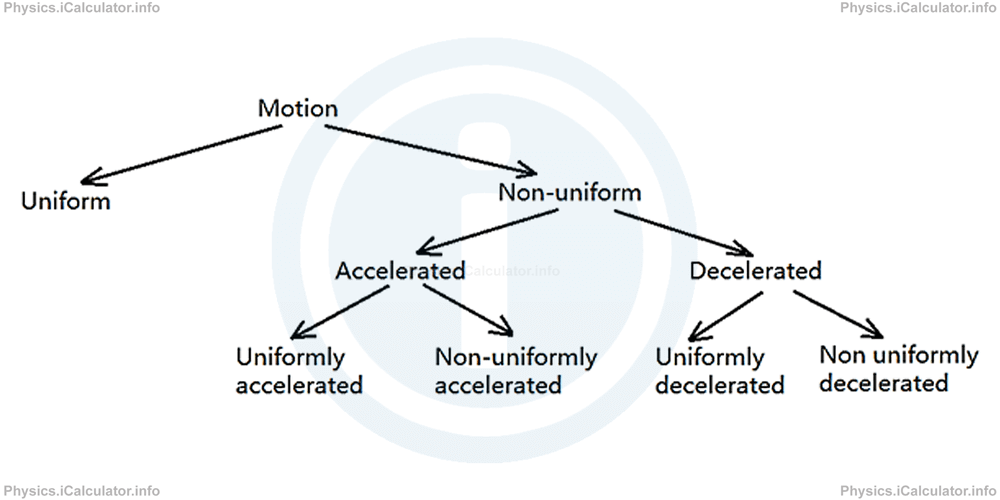Menu
Motion. Types of Motion
Please provide a rating, it takes seconds and helps us to keep this resource free for all to use
In addition to the revision notes for Motion. Types of Motion on this page, you can also access the following Kinematics learning resources for Motion. Types of Motion
| Tutorial ID | Title | Tutorial | Video Tutorial | Revision Notes | Revision Questions | |
|---|---|---|---|---|---|---|
| 3.1 | Motion. Types of Motion |
In these revision notes for Motion. Types of Motion, we cover the following key points:
- The meaning of motion
- Classification of motion according to the moving rhythm (intensity)
- Classification of motion according to the path
Motion. Types of Motion Revision Notes
In Physics, anything that keeps changing its LOCATION with respect to TIME is said to be in motion. Mathematically, Motion is described in terms of displacement, distance, velocity, acceleration, speed, and time.
In Physics, Motion is classified according to two main criteria:
- According to the moving intensity (rhythm), and
- According to the path's shape
The first category is further divided into more specific sub-categories, which are shown in the scheme below.

Thus, if an object moves at the same intensity (rhythm) there is a uniform motion. If it speeds up (increases its moving rhythm) we say the object is experiencing an accelerated motion and if it slows down (reduces its moving rhythm) we say it is experiencing a decelerated motion.
Further, if the increase (decrease) in the moving rhythm remains unchanged during the entire process, there is a uniformly accelerated (decelerated) motion. Otherwise, it is non-uniformly accelerated (decelerated) motion.
As for the classification of motion according to the path's shape, we have the following sub-categories:
Rectilinear (in short Linear) Motion
This is a kind of motion, in which the object moves in a straight line.
Circular (Rotatory) Motion
In this kind of motion, the object moves in a circular path, i.e. it revolves around a fixed point (the centre) at the same distance (radius r) from it.
Curvilinear Motion
Curvilinear Motion describes an object moving according along a curved path.
Vibratory (Vibrational) Motion
This is a back and forth motion around a fixed point, which is known as the "equilibrium position".
Projectile Motion (Ballistics)
This kind of motion typically occurs when we throw an object at an angle different from 00 and 900 to the horizontal direction. The trajectory of a projectile is parabolic due to the attraction effect of gravity.
Elliptic Motion
This kind of motion describes and object moving according an elliptic path.
Combined Motion
If two or more of the abovementioned motions are combined, other types of trajectory (which are worth to mention) are created. Some of them include:
Oscillatory Motion
This kind of motion is a combination of circular and vibratory ones. That is, the object swings around an equilibrium position but not in a straight line.
Wavy (sinusoidal) Motion
In this kind of motion there is a combination of rectilinear and vibrational ones.
Whats next?
Enjoy the "Motion. Types of Motion" revision notes? People who liked the "Motion. Types of Motion" revision notes found the following resources useful:
- Revision Notes Feedback. Helps other - Leave a rating for this revision notes (see below)
- Kinematics Physics tutorial: Motion. Types of Motion. Read the Motion. Types of Motion physics tutorial and build your physics knowledge of Kinematics
- Kinematics Practice Questions: Motion. Types of Motion. Test and improve your knowledge of Motion. Types of Motion with example questins and answers
- Check your calculations for Kinematics questions with our excellent Kinematics calculators which contain full equations and calculations clearly displayed line by line. See the Kinematics Calculators by iCalculator™ below.
- Continuing learning kinematics - read our next physics tutorial: Position, Reference Point
Help others Learning Physics just like you
Please provide a rating, it takes seconds and helps us to keep this resource free for all to use
We hope you found this Physics tutorial "Motion. Types of Motion" useful. If you did it would be great if you could spare the time to rate this physics tutorial (simply click on the number of stars that match your assessment of this physics learning aide) and/or share on social media, this helps us identify popular tutorials and calculators and expand our free learning resources to support our users around the world have free access to expand their knowledge of physics and other disciplines.